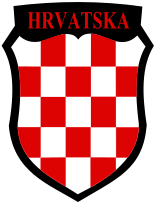| 369th (Croatian) Infantry Division 369. (Kroatische) Infanterie-Division 369. (hrvatska) pješačka divizija | |
|---|---|
 Sleeve insignia of the division worn on the right upper arm[1] | |
| Active | 1942–1945 |
| Allegiance | |
| Branch | German Army (Wehrmacht) |
| Type | Infantry |
| Role | Anti-Partisan operations |
| Size | Division (14,000 men)[2] |
| Garrison/HQ | Stockerau, Wehrkreis XVII |
| Nickname(s) | Devil's Division |
| Motto(s) | Što Bog da i sreća junačka "By the grace of God and the fortune of heroes" |
| Engagements | |
| Commanders | |
| Notable commanders | Fritz Neidholt (1942–44) |
The 369th (Croatian) Infantry Division (German: 369. (Kroatische) Infanterie-Division, Croatian: 369. (hrvatska) pješačka divizija) was a legionary division of the German Army (Wehrmacht) during World War II.
It was formed with Croat volunteers from the Independent State of Croatia (NDH), a puppet state of Nazi Germany in occupied Yugoslavia, and with surviving members of the 369th Croatian Reinforced Infantry Regiment annihilated during the battle of Stalingrad, in honour of which it received its ordinal. It adopted the nickname of Vražja Divizija (Devil’s Division) as a tribute to the 42nd Landwehr Division of World War I, a Croatian unit of the Austro-Hungarian Army. Numbering 14,000 troops and organised into two infantry regiments, the division was commanded by about 3,500 German officers, non-commissioned officers, and specialists.
By December 1942, the German High Command chose to deploy the division in the Balkans to fight Tito's Communist Partisans. Its first major combat operation took place during Operation Weiss in northern Bosnia, it then participated in Operation Schwartz from 15 May to 16 June 1943, the two largest anti-guerrilla operations conducted by the Wehrmacht during the war. After the capitulation of Italy, the division operated alongside another Croatian Legion, the 373rd (Croatian) Infantry Division as well as the Waffen-SS Division “Prinz Eugen”, a division consisting mainly of Volksdeutsche from the NDH and the Banat, and other German and Croatian units.
On 11 September 1944, under orders from its commandant, the 369th division destroyed two villages near Stolac, hanging all the men and driving away all the women and children.[3] According to British historian Ben H. Shepherd the only way in which this division distinguished itself was in the number of civilians it killed.[4]
The last remaining personnel of the 369th formally surrendered to the British forces in May 1945. Following the Nuremberg Trial, General Neidholt, commandant of the division, was found guilty of war crimes; he was executed by hanging on 27 February 1947.[2]
- ^ Littlejohn 1979, p. 187.
- ^ a b Brnardic & Aralica 2016, p. 16.
- ^ United States. Department of State, United States. War Department & International Military Tribunal 1946, p. 50.
- ^ Shepherd 2012, p. 215.